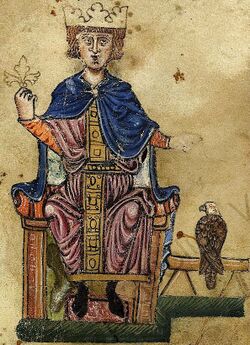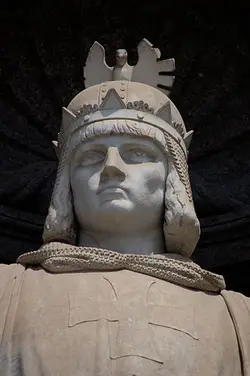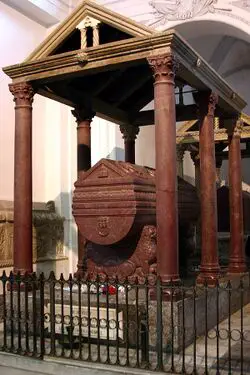What was the influence of Emperor Frederick II on the Italian Renaissance
Frederick II, (26 December 1194 – 13 December 1250) Holy Roman Emperor and King of Sicily was one of the most remarkable monarchs of the Middle Ages and indeed in the entire history of Europe. He was the ruler of all Germany and all of Southern Italy. He was one of the most powerful men in the Middle ages, and he attempted to change the political system of Medieval Europe. He had many ambitious political plans, but they all failed. In many ways, Frederick II can be considered a remarkable failure, but he had a decisive influence on the development of the Renaissance.
Frederick II can be viewed as the first ‘Renaissance Prince.’’ He was a remarkable character, and due to his many accomplishments, he was commonly known as ‘Stupor Mundi’’ or the ‘Wonder of the World.’’[1] The big question is what influence did Frederick II had on the Italian Renaissance, and what did he accomplish through his cultural patronage? Ultimately, his secular and rational outlook helped shape the Renaissance.
Background
In 1196, Henry VI Hohenstaufen secured the election of his infant son as Holy Roman Emperor. However, the German nobles rebelled, and Frederick was raised in Sicily. His mother secured the Crown of Sicily, a large kingdom that included Sicily and all Southern Italy. Frederick was king in name, and it was only when he gained manhood that he really ruled his kingdom. After the defeat of his rival in France, Frederick was crowned as Holy Roman Emperor.[2] However, he resided in Sicily, and he proved to be a shrewd and capable ruler. He managed to pacify the island, and he was a tolerant ruler. He was greatly interested in other cultures and treated the Christian, Jewish, and Muslim inhabitants of his kingdom equally. Soon his relationship with the Pope deteriorated as he broke a promise to separate southern Italy from his kingdom in Sicily.
Frederick ruled Germany through a regent, and he ruled all his many lands from Palermo, Sicily[3]. He created a modern state in his kingdom and transported rebellious Muslim inhabitants to the mainland. It was expected that as the most powerful monarch in Christendom, he would go on a crusade and attempt to reclaim the Holy Land for the Christians. When he was unable to go on Crusade, he was excommunicated by the Pope. At this time, he began a conflict with the Northern Italian City-States, which was to last until his death. Still excommunicated, the Emperor went on crusade and entered into negotiations with the Fatimid Sultan, and he secured a diplomatic coup. He was able to gain Jerusalem and Bethlehem through diplomacy, and he later crowned himself King of Jerusalem.[4]
Soon he was involved in a brutal war with the League of Italian States (The Lombard League). Some cities sided with the Emperor, and a vicious war raged through Italy until Frederick’s death. Frederick sought to make himself the undisputed master of Italy and also to subject Pope to his will. At the same time, he fought a civil war in his German lands.[5] The wars drained Frederick's resources, and he was forced to compromise. He agreed to make concessions to the German nobles, which greatly reduced the power of the Emperor in Germany. Frederick’s son rose in revolt against this settlement, by he was soon defeated. In 1236 Frederick, waged war against the Lombard cities. With some success, and he was on the verge of victory, the Pope intervened. Pope Gregory IX did not want an Italy dominated by Frederick. The Emperor responded by seizing most of the Papal States.
Gregory IX died, and Frederick tried to negotiate with his successor after he had suffered a series of defeats such as at the Siege of Parma. However, the war once more turned in Frederick’s favor, and he was on the verge of total victory when he died of dysentery in his beloved Sicily. Soon after his death, his empire fell apart. In Germany, the ‘Great Interregnum’ began when there was no Emperor for several decades. Hohenstaufen was to sit on the Throne of the Holy Roman Emperor, again. Later a French noble supported by the Pope conquered the Kingdom of Sicily and executed Frederick’s son, Manfred. The Hohenstaufen Dynasty was at an end.[6] Frederick II was such a remarkable character that many people expected him to return from the dead and saw him in messianic terms.[7]
Frederick II’ Court at Palermo
Frederick was a tolerant ruler, and he was fascinated by different cultures and the exotic. He liked to fill his court with learned men and ar sts. Now previously, royal courts had patronized poets but not to the extent of Frederick II. The Emperor sponsored many artists and poets but also patronized scientists such as astronomers. Frederick also showed an interest in exotic animals and had his own zoo. The Emperor’s Court became a model for Renaissance Princes. Frederick believed in the power of culture and that a prince’s duty was to promote and protect the arts and men of learning. This involved commissioning works and supporting them financially. The example of Frederick II Court in Palermo and his example of patronage was to greatly influenced to influence many leaders in Italy greatly to emulate the Court of Fredrick in Italy, and many followed his example, and this meant that many artists and writers had generous patrons, and this was to prove to be a crucial factor in the Renaissance.[8]
Frederick II and Reason
The Renaissance is often seen as an era where reason prevailed and as a departure from Middle Ages. Frederick II was a rationalist, and unlike his contemporaries, he did not defer to tradition but sought to apply reason to every aspect of his state and his policies.[9] Frederick II used rational principles to create one of Europe’s first centralized states, since the Fall of the Roman Empire. He demonstrated to succeeding generations that reason could be used to build a state and to perfect it. This greatly influenced the ‘state as a work of art’ and used reason rather than tradition to mold and administer their domain.[10]
Frederick’s rationality is best seen in his laws. He developed new and progressive law codes for both his kingdom of Sicily and his German realms. He based his new laws on reason and did not believe that tradition or custom had any role in legal reasoning and the legal code. For example, he outlawed trial by combat as a way of determining a law case.[11] He declared it to be irrational. Frederick also issued directives that can be seen as very rational and progressive. He ordered physicians (doctors) be to distinguished from apothecaries (chemists), and none could practice both occupations. Frederick encouraged scientific investigation at his court. He himself wrote a book on falconry anatomy and behavior. He also encouraged the investigation of the natural phenomenon at his court. Frederick made the investigation of nature popular among the learned. This was to inspire others to begin to investigate nature, and the ‘re-discovery of nature is one of the preoccupations of the Renaissance.[12]

This new interest in nature was to lead to the growth in education and did much to lay the foundations for modern science. However, not all Frederick’s experiments are commendable. He also ordered experiments to be carried out on human beings. One example is the notorious language deprivation experiment where young infants were raised without human contact to see what language they would speak. However, none ever did speak, and they all died. Frederick believed that education was extremely beneficial, and this idea, quite novel, proved influential in the Renaissance. The Emperor founded the University of Naples, and it was to become one of the leading centers of learning in Europe. Many leading humanists who contributed to the Renaissance studied at Frederick’s university.
Frederick II and the Muslim World
Frederick II was widely accused of being a heretic or even of being the Anti-Christ, mostly by supporters my, the Pope. In truth, Frederick was a devout Christian, and although excommunicated, he died in a monk’s habit. He certainly was an unorthodox Christian and was interested in other cultures. His Kingdom of Sicily was a multicultural one, where, Italian, Jew, Norman, and Muslim lived as neighbors because of its recent turbulent history. Frederick was extremely tolerant for his times, and this was undoubtedly a necessity in his multicultural kingdom.[13]
However, he was also genuinely interested in Muslim and Jewish culture. As a result, his Court in Palermo was a cosmopolitan one and soon became the most cultured in Europe and the Middle East. Frederick's acceptance of different cultures was to have a real impact on the development o the Renaissance. The Muslim World, unlike Europe, was very much interested in ancient learning, especially that of the Greeks. Muslim scribes and scholars had done much to preserve the learning of the Classical World. Frederick II organized for many Greek manuscripts to be brought to his court in Palermo. He commissioned them to be translated by Jewish and Muslim translators, and as a result. As new or improved versions of great works by Greek philosophers, mathematicians, scientists, and others these works did much to promote an interest in the Classical World and indeed efforts to emulate the Roman and the Greek world, one of the chief characteristics of the Renaissance.[14]
Frederick II and Literature and Language
Perhaps Frederick’s greatest contribution to the development of the Renaissance was in literature and the Italian Language. Frederick could speak six languages, and he loved poetry. He was himself a poet and appreciated the company of poets. At his court, a group of poets known as the Sicilian School flourished. This group of poets, possibly influenced by Arabic and Provencal exampled new styles and ways of expressing their themes.[15] The poets of the Sicilian Schools extolled a new kind of poetry based on their own personal experiences and above all, they helped to perfect the love lyric.
The School was also very important in the development of the sonnet, a form that was to be used by many of the grcriticalf the Renaissance in Italy and, indeed, elsewhere. They were the first to use an Italian dialect as a literary language and did not seek to write in Latin. This was to have a great influence on Renaissance literature and helhe development of an Italian literary language.[16] The poets were to hadevelopce on the development of the Italian literary language, the language that was used by Dante, Petrarch, Boccaccio, and others. Many of these writers freely acknowledged thewhichcilian School. Dante acknowledged Frederick II’s role in the development of a literary language and Italian poetry even though he consigned the Emperor to hell in his great poem, the Ideveloping, The Inferno, trans by Mark Musa (Penguin, London, 1990), p. 115</ref>
Conclusion
Frederick II was a remarkable man, and he dominated his era. He was an international figure, and if he had succeeded in his plans, he could have changed European history. His abiding achievement was possibly in the field of culture. He patronized artists and writers, and this was emulated by later rulers. This was to be very important in the Renaissance. The Emperor also facilitated the translation and dissemination of many works from the Greeks, and they too were influential. Frederick II valued reason in politics, his administration, and the law, he also encouraged empirical investigation, and this was to have inspired, a literary patron, he made a lasting impression on the development of the Renaissance. His patronage of the Sicilian School was to change the lay the foundations for Renaissance literature. The role of Frederick II should not be overstated, but nonetheless, he helped to create an environment in Italy that helped promote the Renaissance.
===Reference
- Jump up ↑ Kantorowicz, Ernst. Frederick the Second, 1194–1250 (London, Longman, 1931), p. 167
- Jump up ↑ Abulafia, David. Frederick II. A Medieval Emperor (Penguin Press, London, 1988), p. 78
- Jump up ↑ Abulafia, p. 113
- Jump up ↑ Smith, Thomas W. "Between two kings: Pope Honorius III and the seizure of the Kingdom of Jerusalem by Frederick II in 1225." Journal of Medieval History 41 #1 (2015): 41-59
- Jump up ↑ Abulafia, p. 117
- Jump up ↑ Abulafia, p. 117
- Jump up ↑ Cohn, Norman, Millenarianism in the Middle Ages (Penguin, London, 1980), p 167
- Jump up ↑ Abulafia, p. 119
- Jump up ↑ Abulafia, p. 119
- Jump up ↑ Burkhardt, Jacob, The Civilization of the Renaissance in Italy (Penguin, London, 1992), p. 167
- Jump up ↑ Burkhardt, p. 117
- Jump up ↑ Burkhardt, p. 119
- Jump up ↑ Kantorowicz, p. 176
- Jump up ↑ Kantorowicz, p. 178
- Jump up ↑ G. Marrone, P. Puppa, and L. Somigli, (eds). Encyclopaedia of Italian literary studies, Volume I (Longman, UK, 2007), p782
- Jump up ↑ Burckhardt, p. 115
Related DailyHistory.org Articles
- Why did the Italian Renaissance End?
- How did the Bubonic Plague make the Italian Renaissance possible?
- What was the role of the Popes in the Renaissance?
- What were the causes of the Northern Renaissance?
- How did the Renaissance influence the Reformation?
- What was the Borgias contribution to Renaissance Italy?


